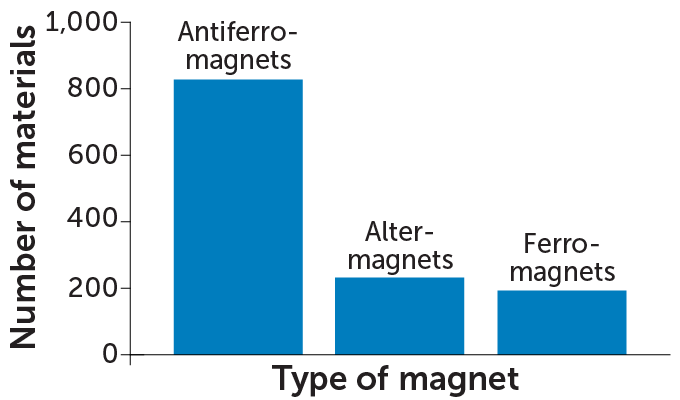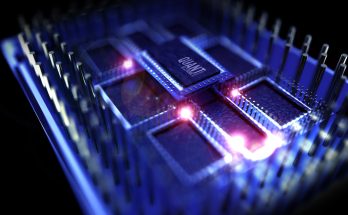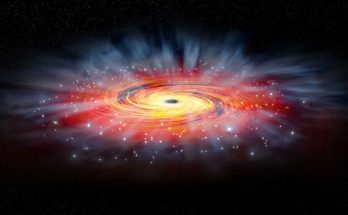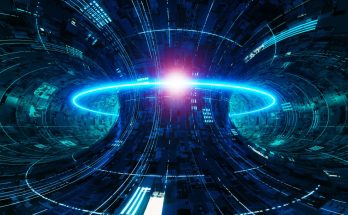For the first time in nearly a century, physicists have identified a brand new type of magnetic material.
Crack open a physics textbook and you may read that scientists classify magnetic materials into two main types: ferromagnets and antiferromagnets. Ferromagnets are what most people think of when magnets come to mind. These materials possess a magnetic field that lets them hold up photos on a refrigerator or cause a magnetic compass to point north. Antiferromagnets have no external magnetic field but have other magnetic quirks.
Now, that classic pair has become a trio. Physicists have reported a new class of magnetic materials called altermagnets, which could lead to new technologies such as faster, more efficient computer hard drives.
Even though the idea behind altermagnets is extremely simple, says theoretical physicist Igor Mazin of George Mason University in Fairfax, Va., “somehow … nobody thought about this possibility” until recently. The fact that a third magnetic category could have remained unnoticed this long, “it’s very surprising to me.”
That’s because the study of magnetic materials is an ancient science. Ferromagnets have been known for thousands of years. Lodestone, a magnetized form of the mineral magnetite, fascinated the ancient Greeks. The Chinese forged the magnetized mineral into the first compasses in the fourth century B.C. (SN: 1/28/11). Antiferromagnets were discovered in the 1930s.
Then, a few years ago, theoretical predictions suggested altermagnets could exist. And when scientists began searching for them, researchers quickly discovered that the magnetic materials were real and plentiful.
Altermagnets are their own class
On a microscopic level, materials get their magnetism from their atoms. The atoms have spin, a quantum mechanical property bestowed by the atoms’ electrons. That spin makes each atom act like a minuscule magnet. The spins can point in different directions, normally called spin up and spin down. Any material with spins arranged in an orderly way — in the absence of any externally imposed magnetic field — is considered a magnetic material by physicists.
In ferromagnets, the atoms’ spins align, so that their magnetic fields combine to create a magnetic field that surrounds the material. Antiferromagnets do the opposite: The atoms’ spins point in alternating directions, and their magnetic fields cancel out, producing no net field.
In altermagnets, the atoms’ spins alternate, but with an added twist. Not only are the spins of neighboring atoms opposite, but the atoms are also rotated. If you think of antiferromagnets like a checkerboard, with alternating black and white squares standing in for spin up and spin down, then altermagnets are like an M.C. Escher drawing, with tessellating shapes — birds, horses or another of Escher’s motifs — that don’t just alternate in color but are also rotated with respect to one another.
If you take an altermagnet, flip its spins around, and rotate the material — by 90 degrees, for example — it will look identical to its original state. That’s a special type of symmetry, different from other magnetic materials. And this symmetry puts altermagnets in their own class, Jairo Sinova of Johannes Gutenberg University Mainz and colleagues argued in Physical Review X in September 2022 — one of a smattering of theoretical papers since 2019 that helped put altermagnets on the map.
Experiments have now begun confirming the altermagnetic identities of certain materials.
Altermagnets get real
Scientists predicted that the electrons within altermagnet materials would have some unusual characteristics. To confirm the altermagnetic nature of a given material, scientists need to map out that electron behavior. Particularly important is plotting out how the energy of an electron in the material relates to its momentum. In ferromagnets, electrons with a given energy on that map split up: The momentum depends on the spin. Spin up electrons will have a different momentum than spin down electrons of the same energy.
In antiferromagnets, however, spin up and spin down electrons are the same. For a given energy, both spins will have the same momentum.
Here’s where altermagnets’ weird dual nature comes into play. Scientists predicted that the materials’ electrons would be split according to spin, but only for electrons moving in certain directions. That means, in some orientations the material will act like a ferromagnet, and in others like an antiferromagnet.
To confirm this effect, scientists used a technique called angle-resolved photoemission spectroscopy, which measures the electrons emitted when a material is hit with light. With that method, researchers observed spin splitting in the material manganese telluride. The material has been studied since the 1960s and was previously thought to be well understood as an antiferromagnet. But the results matched predicted altermagnetic behavior, researchers reported in the Feb. 15 Nature.
Around the same time, two other teams also found evidence of spin splitting in manganese telluride, according to papers published in the Jan. 19 Physical Review Letters and the March 15 Physical Review B.
And more altermagnetic materials are cropping up. A paper in the Feb. 2 Science Advances found hallmarks of altermagnetism in ruthenium dioxide, and a March 8 paper in Nature Communications described altermagnetic behavior in thin films of a compound of chromium and antimony.
“The bottom line is … it’s not only one rare system” that hosts an altermagnet, says physicist Libor Šmejkal of Johannes Gutenberg University Mainz in Germany. And the results confirmed that altermagnets aren’t just theoretical. They are a new, third class of magnetic material.
Not only are altermagnets found in multiple materials, but there are more altermagnet candidates than there are ferromagnets. And the materials aren’t obscure or toxic, says experimental physicist Helena Reichlová of the Institute of Physics of the Czech Academy of Sciences in Prague. Researchers already know how to produce and work with these materials. “They are already here with us, they were just hidden to us.”
The new magnets find their niche
Altermagnets’ nature could make them particularly suited to certain technological applications. Currently, ferromagnets are used for magnetic computer hard drives, which encode 0s and 1s in tiny magnetic bits. But the technology is limited by ferromagnets’ magnetic fields. “This magnetization in ferromagnets, it’s the source of all these exciting effects which we, for instance, use in hard drives,” Šmejkal says. “But at the same time, it’s [an] enemy.”
Magnetic bits are difficult to pack tightly: Ferromagnets placed in close proximity can interfere with one another via their magnetic fields. And the magnetic bits have a speed limit: They can be switched from 0 to 1 only so fast. So, scientists had considered replacing ferromagnets with antiferromagnets, which have no magnetic field. But there’s a problem with that plan. To read out data, hard drives take advantage of the spin-splitting behavior of ferromagnets. In antiferromagnets, electrons don’t split up according to spin.
Altermagnets, which have no net magnetic field but do split electrons by spin, could provide the best of both worlds. Altermagnetism “seems to remedy some of the key limitations of ferromagnets,” says physicist Tomáš Jungwirth of the Institute of Physics of the Czech Academy of Sciences.
What’s more, whereas ferromagnets tend to be metals, altermagnets can be made of a variety of material types (SN: 1/11/23). Manganese telluride, for example, is a semiconductor. Because semiconductors are used to make computer chips, scientists hoped that a magnetic material that is also a semiconductor might allow for the possibility of combining a memory and processor in one material (SN: 10/4/13).
With “the best of antiferromagnets, the best of ferromagnets, and a few things that are unique to themselves,” Sinova says, altermagnets are demolishing the limitations of the magnetic status quo. “These materials break all those barriers. They just really plow right through them.”
#Newfound #altermagnets #shatter #magnetic #status #quo
Image Source : www.sciencenews.org




